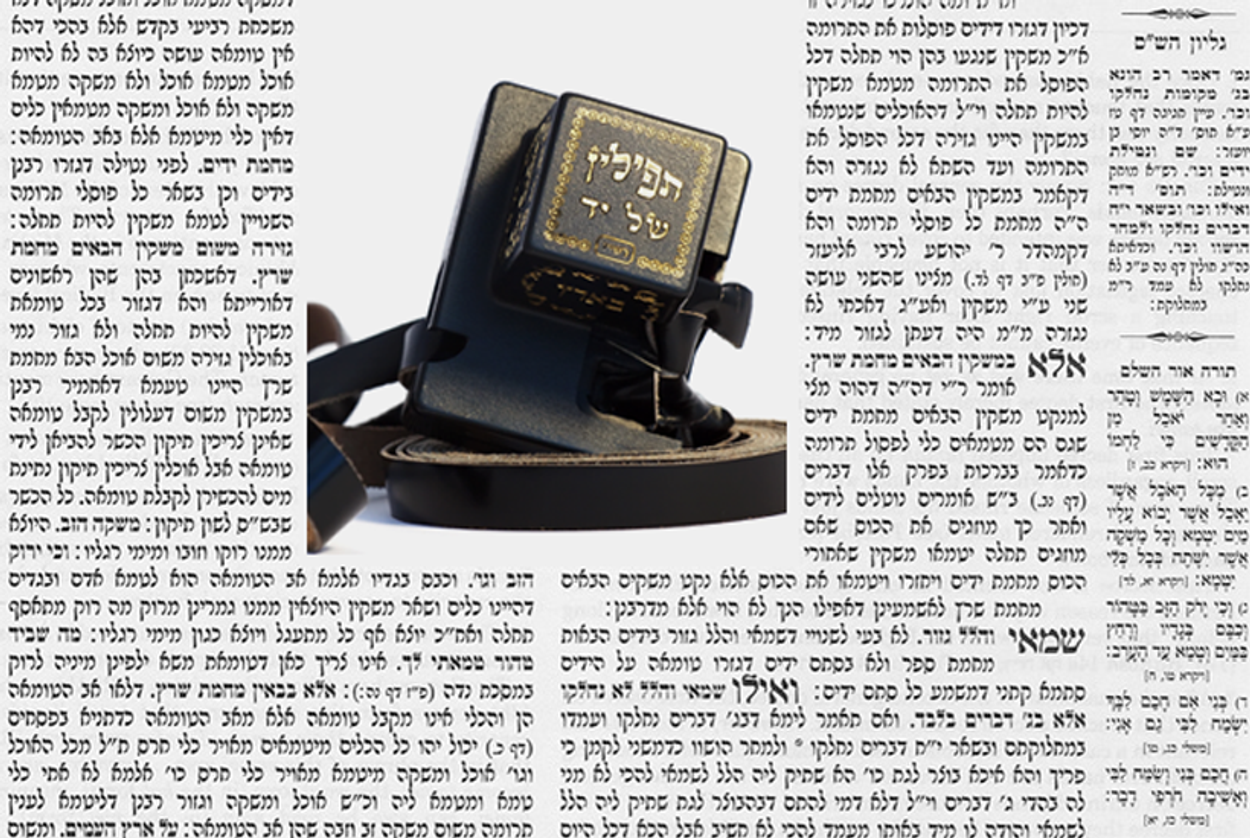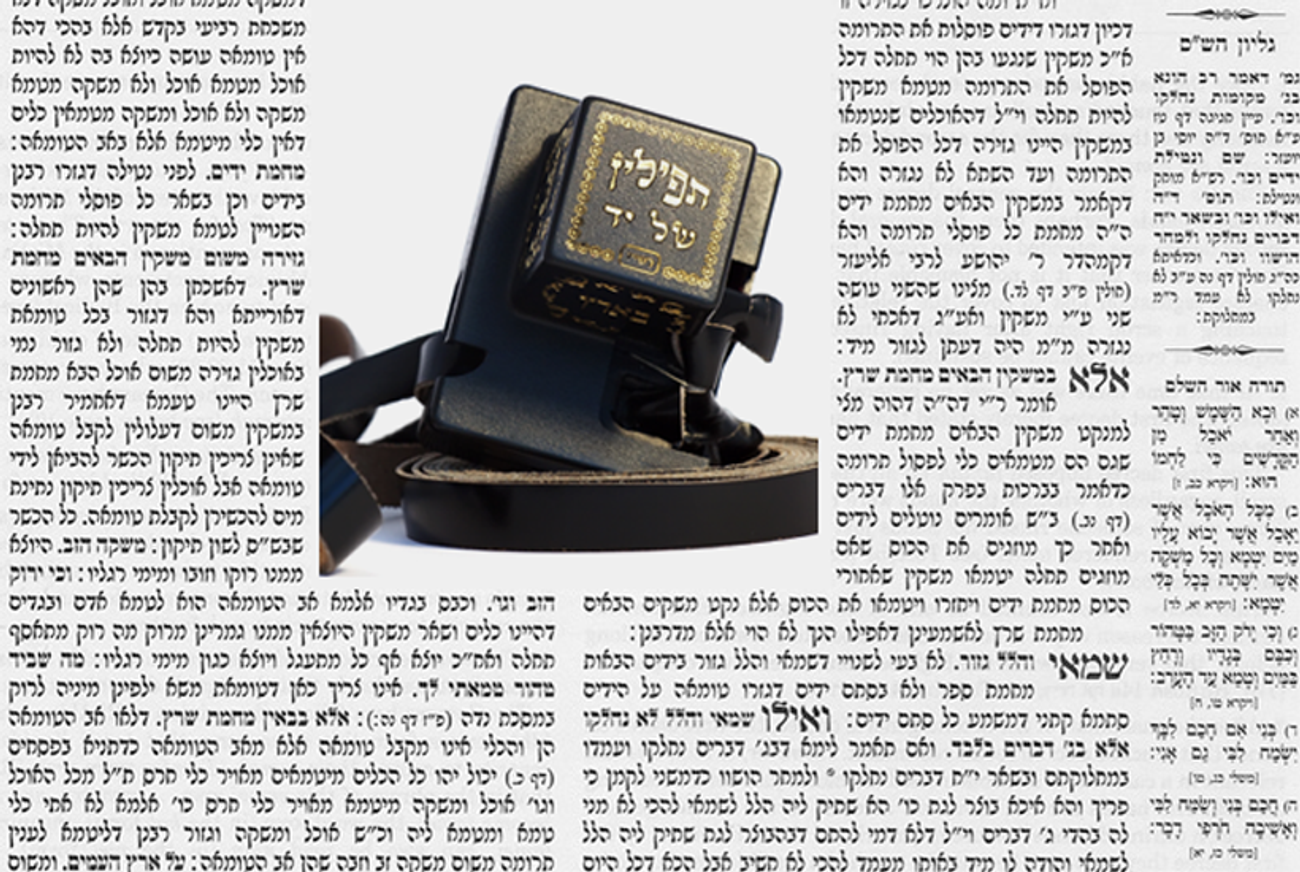How the Talmud Maps Behavior by Exploring Definitions, Not Listing Rules
Daf Yomi: The rabbis examined practical dimensions of deep questions, including those raised around saliva, urine, and sex




Literary critic Adam Kirsch is reading a page of Talmud a day, along with Jews around the world.
This week’s Daf Yomi reading was a wonderful example of the range of the Talmud’s concerns, and the twisting paths that connect them. What starts out as a discussion of the laws of tefillin becomes an examination of the biology of urination and spitting, which is really a debate on the definition of substances and objects. Finally the rabbis turn to questions of sex, marriage, and the status of women, in which the notion of original sin and its punishment is refined in very unexpected ways. Chapter 10 of Tractate Eruvin is all by itself a good argument for the idea that the Talmud is not just a book but an ocean.
One thing I’ve learned over the last year of reading Talmud is that you seldom find subjects in the place where you expect them. You might think, for example, that the question of whether it is permitted to wear tefillin on Shabbat would be covered somewhere in Tractate Shabbat. The subject is addressed there, but it returns for a fuller treatment in Tractate Eruvin, by a roundabout method. What should you do, the Mishnah asks on Eruvin 95a, if you are out walking on Shabbat and you come across some tefillin abandoned in an open field?
Carrying them back home, of course, is forbidden, since you are not allowed to carry anything more than four amot at a time in a public domain. But leaving the tefillin there is also problematic, since they may end up being desecrated. So, the Mishnah recommends a method of carrying that is not really carrying: You should put them on, according to the usual ritual procedure, and then walk home with them. According to Rabban Gamliel, you can even bring them in “two by two”: that is, wearing two sets of tefillin (a set has two pieces, one for the head and one for the arm). If there are more than one pair of abandoned tefillin, you should repeat the procedure as many times as needed. But if there are so many tefillin that it would be impossible to wear them each home before nightfall, the Jew is obligated to stay with them until Shabbat is over.
The Gemara feeds on moments when the Mishnah is ambiguous or contradictory, and so it zeroes in immediately on Rabban Gamliel’s statement. First the Tanna Kamma—the first quoted opinion in the Mishnah, the one that carries the voice of law—holds that a Jew should bring the tefillin home one pair at a time. Why, then, does Rabban Gamliel say he should wear two pairs at a time? What principle underlies this distinction?
The discussion begins by quoting something Rabbi Meir says in Tractate Shabbat about saving clothing from a fire on Shabbat. In such an emergency, the Mishnah rules, it is still forbidden to pick up your clothes and bring them to safety in a big bundle, since that would constitute an act of carrying. However, the opinion of Meir holds, you can wear as many layers of clothing as you can possibly put on and in that way transport them to safety. Because wearing is permitted on Shabbat, it’s allowed to wear as much as you want; after all, on a cold day you might put on a lot of layers of clothing, so the procedure in case of a fire doesn’t differ that much from ordinary use.
Now the Gemara applies this principle to the question of the tefillin. The Mishnah allows wearing lots of layers of clothes in an emergency; why, then, does it only allow wearing one pair of tefillin in an emergency? The answer is that the Mishnah considers wearing tefillin not to be an ordinary act of dressing, but the fulfillment of a particular mitzvah. The mitzvah calls for wearing one pair of tefillin on Shabbat, but not more than one; and God commanded in Deuteronomy 13:1, “You shall take care to do every matter that I command you; neither add to it nor subtract from it.” Wearing two tefillin would be “adding” and therefore a violation.
If Rabban Gamliel does allow wearing two pairs of tefillin, then, it is because—paradoxically, it might seem—he does not consider wearing tefillin to be necessary on Shabbat. Because wearing tefillin on Shabbat is not a mitzvah, it is therefore not a violation to wear more than one pair; according to Rabban Gamliel, it is simply like wearing an ornament, and there is no limit to the number of ornaments you can wear on Shabbat. The Gemara goes on to discuss the practical dimensions of the question: Is there, in fact, room, on one’s forehead and bicep for two tefillin? In the process, the rabbis lay down the rule for exactly where tefillin is to be bound: The head tefillin goes on the kadkod, which is defined as “the place where an infant’s skull is soft.”
Later in Chapter 10, the rabbis return to the much-discussed question of transferring objects between a public domain, a reshut harabim, and a private domain, a reshut hayachid. But the case in point this time is a surprising one. It is forbidden, the Mishnah holds on Eruvin 98b, to stand in a public domain and urinate into a private one, or vice versa (the person in question is presumably a man). The same holds of spitting. Then Rabbi Yehudah follows this logic to its natural conclusion: If saliva is an object that can be transferred between domains, doesn’t it follow that carrying it around in your mouth constitutes an act of carrying? Which means that if your mouth fills with saliva, you cannot go more than four amot in a public domain without spitting it out.
This has some unpleasant hygienic implications—one imagines a lot of spitting going on during Shabbat—but it also has some interesting logical ones. What the rabbis are really debating here, as is often the case, is not so much a point of behavior as one of essences, of definitions. What is an object, really—does it have to have a fixed shape and form, or does liquid count? At what point does saliva cease to be a part of one substance, the body, and become its own substance?
In the Gemara, Rava pushes Rabbi Yehudah’s reasoning a step further by applying it to the question of urination. Urine, too, is a liquid carried inside the body. Should we consider it as part of the body, then, or as a separate object that we carry around inside the bladder? And if urine resides in the bladder, then what happens, Rava asks, if someone (again, the assumption is that we are talking about a man) is standing in such a way that the bladder is in a public domain but the orifice of the penis is in a private domain? Would the passage of urine through the urinary tract then become a forbidden transfer? The question sounds a little absurd—not unlike something that a bright and disruptive student might come up with—and the Talmud decides not even to engage with it: Teku, the rabbis say, “Let it stand” without resolution.
Later in the chapter, the subject shifts to whether a tree’s branches form a valid partition, like a wall. In the course of this discussion, the rabbis say that it is forbidden to walk on grass on Shabbat, on account of a verse from the Book of Proverbs: “And one who acts impetuously with his feet is a sinner.” The application to walking on grass is clear enough; but for the rabbis, raglayim, feet, is also frequently a euphemism for the genitals. The sentence is also applied, therefore, to acting “impetuously” in sexual matters.
For the rabbis, this does not mean, as it might for us, casual or extramarital sex, which are beyond imagining. Instead, Rabbi bar Chama says, it means that “a man is forbidden to force his wife to engage in marital relations.” Rabbi Yehoshua ben Levi seconds, “Whoever forces his wife to engage in marital relations will have children who are not of good character.” For the rabbis, a wife is not property, whom a husband can make use of as he sees fit, but an equal sexual partner, who must always give consent.
Consent, however, is passive. Is a woman also allowed to actually propose sex, to initiate it? Here the rabbis disagree. Rabbi Yochanan says it is highly praiseworthy for a wife to initiate sex: “Every woman who petitions her husband to engage in marital relations will have children the like of whom did not exist even in the generation of Moses.” Rav Yitzchak bar Avdimi, on the other hand, holds that only the husband can explicitly ask for sex: “A woman petitions in her heart, whereas a man petitions verbally.”
This imbalance, he says, is a direct result of Eve’s sin in the Garden of Eden. When she ate the fruit of the tree of knowledge, God laid a series of curses on her, including the phrase, “your craving shall be for your husband, and he shall rule over you.” This “ruling over,” Rav Yitzchak explains, means that the man always has the initiative in sexual matters. Still, the rabbis hold, the woman does have ways of making her desires known: “acting in a pleasing manner,” the Gemara says, is the wife’s way of “petitioning.” The Talmud will never be accused of strict egalitarianism, but its treatment of marital relations and sexual dynamics seems pretty progressive for a work that is more than 1,500 years old.
***
Like this article? Sign up for our Daily Digest to get Tablet Magazine’s new content in your inbox each morning.
Adam Kirsch is a poet and literary critic, whose books include The People and the Books: 18 Classics of Jewish Literature.
Adam Kirsch is a poet and literary critic, whose books include The People and the Books: 18 Classics of Jewish Literature.